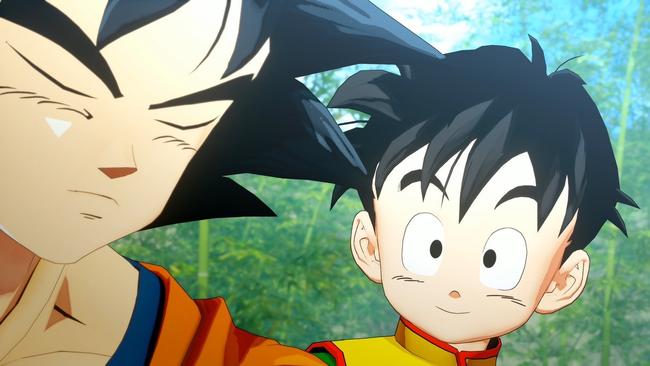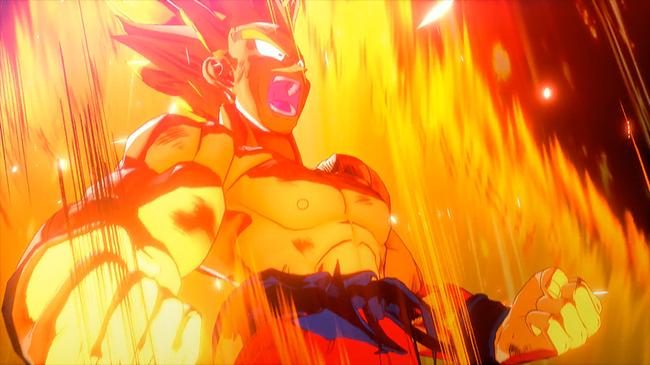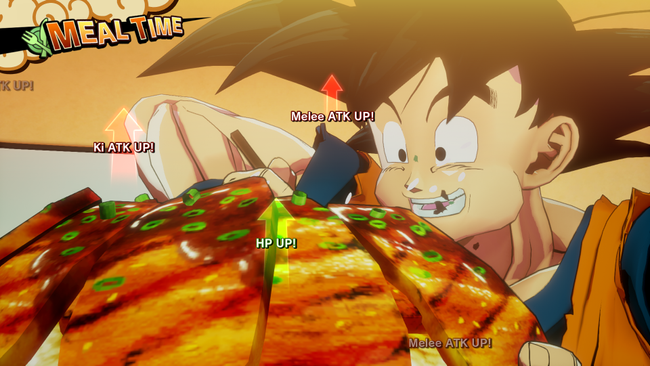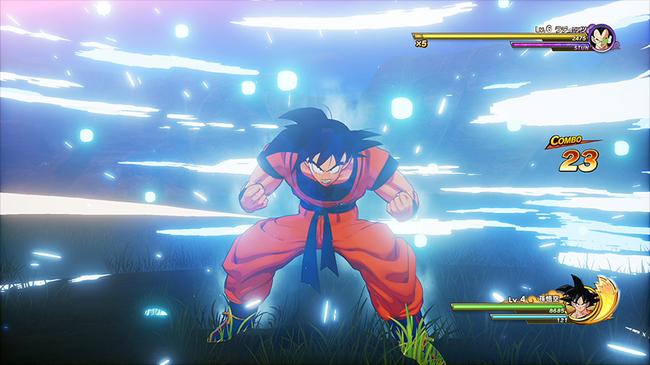Dragon Ball Z: Kakarot Review
For some people, Dragon Ball is all about the fighting. The epic beam struggles, the rising power levels and the threat of five-minute planetary annihilation. Although seeing it as a galactic power fantasy is a fine way of thinking, a lot of people overlook that and, to many, Dragon Ball is all about the sense of adventure. The massive bowls of food, the far-off lands travelled by flying cloud and the idea that martial arts can take you on a journey. Too many times have the games overlooked this element, and we’ve all been crying out for something a little different. This is exactly what Dragon Ball Z: Kakarot aims to do.
CyberConnect2 had the task of taking those two elements and crafting a full-scale console RPG for the series. I’d say they’ve managed it pretty well, creating an enjoyable gameplay loop inside a loving recreation of Dragon Ball Z, although unfortunately, it can't avoid being bogged down by some of the RPG elements forced into the proceedings.
In regards to the story, Dragon Ball Z: Kakarot is a recreation of the events of Dragon Ball Z, which means everything from Goku vs Raditz, all the way to Goku vs Kid Buu. For those people who’ve experienced it all before, it might be a bit much to ask for a 40-hour adventure of the same events, but the level of detail that’s put into it all is remarkable.

Rather than skipping the little things, Dragon Ball Z: Kakarot embraces them. It doesn’t forget that King Kai made Goku tell him a joke before training, it doesn’t forget about Vegeta’s Badman T-Shirt, and it doesn’t forget that Dragon Ball is just as much about the intimate moments as it is about the explosive ones. Calling it a good entry point for newcomers might be a bit of a stretch, but it’s definitely the best representation of the story that a Dragon Ball game has ever seen. Because of all of the love put into recreating these little scenes, the few times where the game doesn’t deliver can be a bit surprising. The lack of Uub, Gohan’s first transformation into a Super Saiyan in the Hyperbolic Time Chamber, and a few other instances of missing story content are a little jarring, although this a minor complaint to make compared to everything else the game does right.
With all of this detail, Dragon Ball Z: Kakarot is a meaty experience. Going through the story and doing a small amount of side-missions and exploration took me 30 hours, whilst trying to get all of the post-game content done could easily add another 15-20. When the game was first revealed, it was a little disappointing to not see Dragon Ball Super representation, but they’ve definitely made the right move putting a laser-tight focus on Z.
Kakarot also nails the look of the series in a 3D environment. Character models are expressive, particle effects fly off all attacks and the recreated world of Dragon Ball looks really good here. Music and sounds are done just as well, even if the music for the battles can be a little repetitive. Some of the textures can be a bit muddy, and there are instances where characters don’t emote particularly well, but it doesn’t get in the way of the generally fantastic presentation.

The most important scenes in the game are represented through pre-rendered cutscenes, and some of them are absolutely jaw-dropping. After how insane FighterZ looks, I thought it would be hard for a Dragon Ball game to impress me graphically, but Kakarot really impresses in these moments. It’s just a shame that these cutscenes appear in slightly worse quality than the rest of the game, which is especially noticeable in 4K. Technical glitches and slowdowns are also somewhat common throughout the game on PS4, although they’re more of a minor inconvenience than a game-breaker. Seeing a duplicate Goku or a T-posing enemy is a little jarring, but not worth getting upset about.
Dragon Ball Z: Kakarot also touts some new canonical additions to the timeline, but they're not anything too special. The best additions are references and appearances from long-forgotten characters like Launch and a new Ginyu member called Bonyu. It’s always cool to see more representation from the original Dragon Ball, but it doesn’t change the game in any major way.
If it hasn’t been made clear already, one of the biggest strengths of Dragon Ball Z: Kakarot is the amount of love that has been poured into it. CyberConnect2 are clearly big fans of the series, and it seems like they had a blast diving into the universe. One of the ways this is best shown is with the Z Encyclopedia. This book is packed with models and information on each character, as well as housing music from the anime and some really cool little bonuses. Something this exhaustive didn’t really need to be included, but for Dragon Ball fans it’s almost worth the price of admission alone.

Gameplay is both very different and very similar to previous Dragon Ball games. You spend a lot of time fighting enemies as you’d expect, but there’s also a lot of time spent flying from area to area, talking to people and trying to raise your level. Much has been made of the RPG elements in Kakarot, but the end result is a little mixed. The focus on the smaller elements of the Dragon Ball experience is what shines best. Having this big world to explore full of little collectibles, enemies to fight and people to talk to is something we’ve never really seen in a Dragon Ball game before and for a fan like me, it’s a dream come true to be able to fly around the Dragon Ball world, or drive in a little car whilst blasting music from the show. There’s never been a chance to do this in such detail, which makes it totally worthwhile for mega-fans, although it’ll certainly mean a lot less to casual fans.
Despite being titled “Kakarot”, there are a surprising amount of playable characters in the story, all with their own skill tree and moves. Having a party of Z-Warriors follow you around in and out of the battlefield is great fun, and the ability to switch between them and level them up adds a lot of replay value for completionists. Although levelling up your characters is a fun idea in practise, it’s not really necessary at any point in the main story. You get enough experience points from just going from story mission to story mission, whilst doing minimal amounts of side-missions or exploration. At the game's onset, you might think you’ll need to grind up levels before big fights, but that really only the case for the first fight against Raditz, before the inevitable story power boosts. The only time you’ll need to dedicate time to powering up is if you’re looking to do all of the post-game content.
Other RPG elements added to Kararot include Z-orbs and cooking. Z-orbs act as the currency for upgrading your skill tree, but they’re available in such abundance that there’s never really a time when you need to collect more. Cooking itself is a bit tedious. It’s overly complicated for what it wants to be, and making a full-course meal (the only food really worth it) is just too time-consuming. From start to finish, Kakarot chucks some new RPG elements at you that end up never really being necessary.

One of the highlights is the focus on training to acquire new moves, but even this isn’t done flawlessly. Each character can unlock brand new moves by levelling up enough and putting points into their skill tree, which then requires you to do a quick battle in order to unlock the move. This matches the show and provides a bit of an extra challenge but it’s let down by having to use D Medals. This currency is sparsely spread out throughout the game, and a lot of the later abilities require quite a lot of these medals, which means you might have to grind it out for a bit. It’s a far cry from the over-abundance of Z-orbs, so resources end up feeling a little unbalanced.
It’s a shame that not all of the RPG elements land quite right, which results in the true meat of the game being its combat. Fighting enemies mostly consists of mashing the attack button and then snap-vanishing around them to try and keep the combo up. It's nothing complicated, but it looks flashy and feels good. Besides having party members and stat buffs, there's nothing really here to label it as an RPG, and similarly to that half of the game, it doesn’t ever really go beyond being just okay. At its best, combat is a fun power fantasy that feels fun to play despite its simplicity, and at its worst, it can just be plain annoying.
The best of the combat comes out in boss battles, which feel well thought out and bleed the most difficulty out of the experience. Some of these fights actually require strategy, and to be a little intimidated by canonically-strong characters like Recoome is genuinely great. One-on-one fights are also a highlight, as it allows you to focus on attacking one enemy without two others hitting you from behind whilst your companions stare blankly.

Sadly, the aggravating elements come out the more you play. Enemies are incredibly reliant on taking ages to charge an attack that stuns you, which means you’ll be spending a lot of time waiting for them to be open, or in the case of my late-game strategy, just mashing beam moves until they snap out of it. Like with the RPG elements, none of it jumps out as straight-up bad or pointless, but none of it goes far beyond being slightly addictive fun. It’s pure Dragon Ball junk food.
Any RPG worth its salt should have optional or post-game content, and Dragon Ball Z: Kakarot actually surprises in that manner. There are a lot of things to come back after the game has finished, although whether you’ll want to is another story. There’s a secret boss, multiple side-missions to unlock with the Dragon Balls, and a wealth of powerful moves to get through training. How much you get from this depends on how much side-content you did during the main story, but as a Dragon Ball junkie who’s seen the saga through a million times before, I found a lot of fun to be had in just exploring the world and doing odd jobs outside of the 30-hour story. Being a massive Dragon Ball fan is pretty much a requirement to get enjoyment out of the extra content. Besides featuring a lot of obscure characters and references, you’ll be overlooking the somewhat simplistic combat and lacklustre RPG elements for at least another 10 hours.
As a Dragon Ball love letter, Dragon Ball Z: Kakarot is nearly perfect, featuring an amazing world and attention to detail. But as an RPG and action-adventure game, it’s only good. Its combat can be fun and some of the more in-depth elements are a good change of pace, but a lot of it feels pointless or time-consuming. Dragon Ball Z fans have a lot to love here, but RPG fans might find themselves wishing for something more.